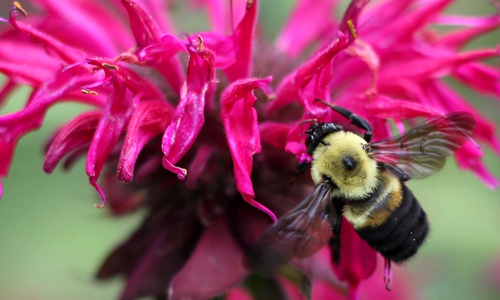

A new website launched yesterday allows people to be directly involved in protecting bumblebees throughout North America. BumbleBeeWatch.org enables people to connect with experts and other enthusiasts, and help build a comprehensive picture of where bumblebees are thriving and where they need help.
[youtube //www.youtube.com/embed/vTLKMAtXGnA?rel=0 expand=1]
Furry, hardworking bumblebees are essential to wildlands, gardens and farms, helping to deliver food security for both people and wildlife alike. Alarmingly, many recent reports suggest that we may be losing their familiar buzz from our summer landscapes due to habitat loss, insecticide use, disease and climate change. More information is needed to determine their conservation status, and that process demands a continent-wide collaborative effort.
“We have an amazing community of citizen scientists who have helped us follow a handful of bee species,” said Rich Hatfield, the Xerces Society conservation biologist who coordinated creation of Bumble Bee Watch. “Hopefully this new website will generate greater awareness and allow us to draw more people into this community.”
A smartphone or simple digital camera (and a computer) is all that’s needed to start exploring BumbleBeeWatch.org. In addition to uploading photos of bumblebees, individuals can identify the bumblebees, learn about their ecology and connect with bumblebee experts and other citizen scientists engaged in pollinator conservation.
The information gathered will help locate rare or endangered populations, as well as track species whose status is less well known. “Bumble Bee Watch will greatly benefit our at-risk pollinator conservation program,” said Sheila Colla, project leader for Wildlife Preservation Canada’s At-Risk Pollinator Project, a partner in Bumble Bee Watch. “By locating rare bumble bee populations and collecting information on their ecological requirements, citizen scientists can help conserve these important insects.”
Bumble Bee Watch is a partnership between the Xerces Society, Wildlife Preservation Canada, the University of Ottawa, the Montreal Insectarium, the Natural History Museum in London and BeeSpotter.
“Bumble Bee Watch unites scientists and conservation organizations in Canada and the United States in the study and protection of North America’s bumblebees,” said Scott Black, executive director of the Xerces Society. “We are grateful for the hard work and commitment that our partners have made. This website will transform the way bumblebees are viewed and protected.”
Visit EcoWatch’s BIODIVERSITY page for more related news on this topic.


 233k
233k  41k
41k  Subscribe
Subscribe 